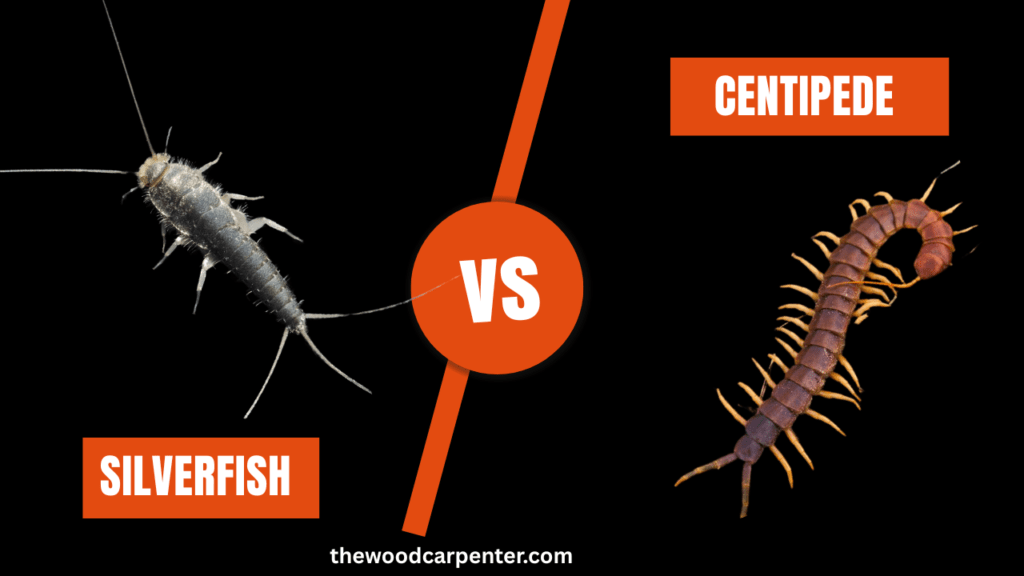
When you spot a creepy, multi-legged pest darting across your floor, it’s easy to wonder: Is it a silverfish or a centipede? While both are common household invaders and share some similarities, they are very different creatures with unique behaviors, appearances, and impacts on your home. Understanding these differences is key to knowing how to react—and whether you should be worried.
What Is a Silverfish?
Silverfish are small, wingless insects named for their silver-gray color and fish-like movements. They are ancient creatures that have been around for over 400 million years.
🔹 Key Features:
Size: ½ to 1 inch long
Color: Silver or gray
Shape: Teardrop-shaped, flat body with long antennae and three tail-like appendages
Speed: Fast crawlers, but not aggressive
Lifespan: Up to 8 years in ideal conditions
🔹 Where You’ll Find Them:
Bathrooms, kitchens, basements
Under sinks, behind wallpaper, in bookcases
They prefer dark, humid, and moist environments
🔹 What They Eat:
Silverfish feed on starches, sugars, paper, glue, book bindings, fabrics, and dead insects.
What Is a House Centipede?
House centipedes are elongated arthropods with many legs and a distinct “creepy-crawly” appearance. Unlike silverfish, centipedes are actually beneficial in some cases, as they hunt and eat other insects.
🔹 Key Features:
Size: 1 to 1.5 inches (can appear larger due to long legs)
Color: Yellow-gray with black stripes
Shape: Long, flat body with 15 pairs of legs
Speed: Extremely fast runners
Lifespan: Around 3 to 6 years
🔹 Where You’ll Find Them:
Damp places like bathrooms, basements, closets
Under sinks, behind baseboards, or near drains
🔹 What They Eat:
Centipedes are carnivorous and feed on cockroaches, silverfish, termites, ants, spiders, and other small pests.
Behavior and Diet
Silverfish are scavengers that feed on starchy materials such as wallpaper, book bindings, natural fabrics, and even food crumbs. They thrive in high humidity and are commonly found in attics, basements, and damp storage areas.
Centipedes are predators. They hunt other insects, including spiders, cockroaches, and even silverfish. Their presence in your home often signals other pest problems, as they are drawn to areas where their prey is abundant. Centipedes move extremely quickly and are usually found in dark, damp spaces like basements and bathrooms.
Potential Damage and Risks
Silverfish do not bite or sting, and they pose no direct threat to humans. However, they can cause significant damage to your belongings, especially paper, fabrics, and stored food. Over time, this can lead to frustration and financial loss as cherished items are destroyed.
Centipedes rarely bite humans, and their venom is not dangerous—though a bite might cause mild irritation. They do not damage property or belongings. In fact, they can be beneficial by controlling other pest populations. However, their rapid movements and unsettling appearance can be alarming to homeowners.
Which Is Worse for Your Home ?
The answer depends on what you consider “worse”:
Silverfish are worse if you value your books, papers, and fabrics. They can silently destroy these items over time, and infestations can be difficult to eliminate without professional help.
Centipedes are worse if you dislike the sight of fast-moving, leggy creatures in your home. However, they are not destructive and may actually help reduce other pest problems.
Prevention and Control
To effectively stop silverfish and centipedes in your home, you should focus on reducing moisture, eliminating their food sources, and sealing entry points. Here’s a step-by-step guide based on the expert recommendations:
Remove Moisture and Dampness
Fix leaky pipes and faucets: Both silverfish and centipedes thrive in damp environments. Repairing leaks removes their preferred habitat.
Use dehumidifiers: Place dehumidifiers in basements, bathrooms, and other high-moisture areas to keep humidity low.
Install exhaust fans: Especially in bathrooms and kitchens, to help reduce humidity.
Remove standing water: Ensure there is no standing water in crawl spaces or around your home’s foundation.
Clean and Declutter
Regular vacuuming: This removes silverfish eggs, food crumbs, and other insects that centipedes prey on.
Clean up spills and food crumbs: Silverfish feed on starches and sugars found in food, paper, and glue. Prompt cleaning reduces their food supply.
Store items properly: Keep books, papers, and clothing in sealed plastic bins, especially in basements and closets.
Reduce clutter: This minimizes hiding spots for both pests.
Seal Entry Points
Seal cracks and gaps: Close any openings around windows, doors, pipes, and walls so pests can’t get inside.
Clean your drains: Silverfish and centipedes can come in through drains. Clean them often using vinegar or a weak bleach solution (but never mix the two).
Use Traps and Repellents
Sticky traps: Place these in corners, along baseboards, and near potential entry points to catch silverfish and centipedes.
Diatomaceous earth: Sprinkle this powder in cracks, corners, and other hiding spots. It is effective and non-toxic for humans and pets.
Boric acid: Apply lightly in problem areas, but use caution around pets and children.
Natural repellents: Essential oils (like cedar, citrus, or lavender), strong-smelling herbs, and spices can help deter these pests.
Eliminate Their Food Sources
Control other insects: Centipedes eat insects like roaches, silverfish, and flies. Reducing these insects helps reduce centipede populations.
Store food securely: Keep food in airtight containers to prevent attracting silverfish.
Additional Tips
DIY silverfish traps: Use glass jars wrapped in masking tape with starchy bait (like bread or flour) inside. Silverfish enter but cannot escape.
Regular maintenance: Consistent cleaning and monitoring will help prevent reinfestation
Final Thoughts
Silverfish and centipedes are both common household pests, but they are very different in appearance, behavior, and impact. Silverfish are more likely to damage your belongings, while centipedes are more likely to startle you but can help control other pests.
Understanding these differences will help you decide which is “worse” for your home and take the right steps to keep both at bay.
Also read:
Natural Mosquito Defense: 9 Plants You Need
Silverfish vs Centipede: Frequently Asked Questions
1. Can silverfish or centipedes harm humans?
A: Neither silverfish nor centipedes are dangerous to people. Silverfish do not bite or sting, while centipedes may bite if handled, but their venom is not harmful to most adults—though it may cause mild irritation.
2. Where are silverfish and centipedes most likely to be found in a home?
A: Silverfish prefer damp, undisturbed places like attics, closets, and basements, while centipedes are often found in similar damp areas but are especially common in bathrooms, cellars, and crawl spaces.
3. Are silverfish or centipedes a sign of a dirty house ?
A: Not necessarily. Both pests are attracted to moisture and hiding spots, not dirt. A clean home can still have issues with either if it is humid or has cracks or clutter.
4. What do silverfish and centipedes eat ?
A: Silverfish feed on starchy materials such as paper, glue, and fabrics. Centipedes are predators and eat other insects like spiders and cockroaches.
5. How quickly can silverfish or centipedes reproduce in a home ?
A: Silverfish reproduce slowly, with females laying a few eggs at a time, but infestations can build up over months or years. Centipedes also reproduce at a moderate rate, but they are more likely to be solitary hunters.
6. Do silverfish or centipedes spread diseases ?
A: Neither silverfish nor centipedes are known to spread diseases to humans.
7. Can I get rid of silverfish or centipedes on my own ?
A: Yes, reducing moisture, sealing entry points, and keeping your home clean can help control both pests. For persistent problems, pest control professionals can provide targeted treatments.
8. Are silverfish or centipedes more active at night ?
A: Both are nocturnal and most active at night, which is why you might only spot them when turning on a light in a dark room.
9. Will silverfish or centipedes damage my home’s structure ?
A: Silverfish can damage books, wallpaper, and fabrics, but neither pest will harm the structure of your home itself.
10. Are there natural repellents for silverfish or centipedes ?
A: Some people use essential oils like cedar or lavender, or natural substances like diatomaceous earth, to deter these pests, but results can vary.

